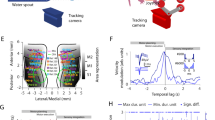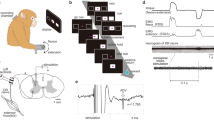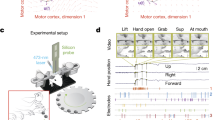Abstract
Preparatory changes in neural activity before the execution of a movement have been documented in tasks that involve an instructed delay period (an interval between a transient instruction cue and a subsequently triggered movement). Such preparatory activity occurs in many motor centres in the brain, including the primary motor cortex1,2,3,4,5,6, premotor cortex7,8,9, supplementary motor area6,10,11 and basal ganglia6,12,13. Activity during the instructed delay period reflects movement planning, as it correlates with parameters of the cue and the subsequent movement (such as direction and extent5,6,9), although it occurs well before muscle activity. How such delay-period activity shapes the ensuing motor action remains unknown. Here we show that spinal interneurons also exhibit early pre-movement delay activity that often differs from their responses during the subsequent muscle activity. This delay activity resembles the set-related activity found in various supraspinal areas, indicating that movement preparation may occur simultaneously over widely distributed regions, including spinal levels. Our results also suggest that two processes occur in the spinal circuitry during this delay period: the motor network is primed with rate changes in the same direction as subsequent movement-related activity; and a superimposed global inhibition suppresses the expression of this activity in muscles.
This is a preview of subscription content, access via your institution
Access options
Subscribe to this journal
Receive 51 print issues and online access
$199.00 per year
only $3.90 per issue
Buy this article
- Purchase on Springer Link
- Instant access to full article PDF
Prices may be subject to local taxes which are calculated during checkout



Similar content being viewed by others
References
Tanji,J. & Evarts,E. V. Anticipatory activity of motor cortex neurons in relation to direction of an intended movement. J. Neurophysiol. 39, 1062–1068 (1976).
Kubota, K. & Hamada,I. Preparatory activity of monkey pyramidal tract neurons related to quick movement onset during visual tracking performance. Brain. Res. 168, 435–439 (1979).
Thach,W. T. Correlation of neural discharge with pattern and force of muscular activity, joint position and direction of intended next movement in motor cortex and cerebellum. J. Neurophysiol. 41, 654– 676 (1978).
Georgopoulos,A. P., Crutcher,M. D. & Schwartz, A. B. Cognitive motor processes. III. Motor cortical prediction of movement direction during an instructed delay period. Exp. Brain. Res. 75, 183–194 ( 1989).
Riehle,A. & Requin,J. Neuronal correlates of the specification of movement direction and force in four cortical areas of the monkey. Behav. Brain Res. 70, 1–13 (1995).
Alexander,G. E. & Crutcher,M. D. Preparation for movement: neural representations of intended direction in three motor areas of the monkey. J. Neurophysiol. 64, 133–150 (1990).
Weinrich,M. & Wise,S. P. The premotor cortex of the monkey. J. Neurosci. 2, 1329–1345 (1982).
Wise,S. P., Weinrich,M. & Mauritz, K. H. Movement-related activity in the premotor cortex of rhesus macaques. Prog. Brain Res. 64, 117–131 (1986).
Kurata,K. Premotor cortex of monkeys: set- and movement-related activity reflecting amplitude and direction of wrist movement. J. Neurophysiol. 69, 187–120 (1993).
Tanji,J., Taniguchi,K. & Saga,T. Supplementary motor area: neuronal response to motor instructions. J. Neurophysiol. 43, 60– 68 (1980).
Tanji,J. & Kurata,K. Contrasting neuronal activity in supplementary and precentral motor cortex of monkeys. I. Responses to instructions determining motor responses to forthcoming signals of different modalities. J. Neurophysiol. 53, 129–141 (1985).
Alexander,G. E. Selective neuronal discharge in monkey putamen reflects intended direction of planned limb movements. Exp. Brain. Res. 67, 623–634 (1987).
Jaeger,D., Gilman,S. & Aldridge, J. W. Primate basal ganglia activity in a precued reaching task: preparation for movement. Exp. Brain Res. 95, 51–64 (1993).
Dum,R. P. & Strick,P. L. The origin of corticospinal projection from premotor areas in the frontal lobe. J. Neurosci. 11, 667–689 (1991).
Requin,J., Bonnet,M. & Semjen,A. in Attention and Performance VI (ed. Dornic, S.) 139–147 (Lawrence Erlbaum, Hillsdale, New Jersey, 1977).
Brunia,C. H., Scheirs,J. G. & Haagh, S. A. Changes of Achilles tendon reflex amplitudes during a fixed foreperiod of four seconds. Psychophysiology 19, 63–70 (1982).
Komiyama,T. & Tanaka,R. The differences in human spinal motoneuron excitability during the foreperiod of a motor task. Exp. Brain Res. 79, 357–364 ( 1990).
Bonnet,M., Requin,J. & Stelmach, G E. Changes in electromyographic responses to muscle stretch, related to the programming of movement parameters. Electroencephalogr. Clin. Neurophysiol. 81, 135–151 ( 1991).
Burke,D., McKeon,B., Skuse,N. F. & Westerman,R. A. Anticipation and fusimotor activity in preparation for a voluntary contraction. J. Physiol. 306, 337–348 (1980).
Gerilovsky,L., Struppler,A., Altman,H. & Velho,F. Spindle activity and monosynaptic reflex excitability during foreperiod. Electroencephalogr. Clin. Neurophysiol. 56, 487–493 (1983).
Kuypers,H. G. & Brinkman,J. Precentral projections to different parts of the spinal intermediate zone in the rhesus monkey. Brain Res. 24, 29–48 ( 1970).
Murray,E. A. & Coulter,J. D. Organization of corticospinal neurons in the monkey. J. Comp. Neurol. 195, 339–365 (1981).
Toyoshima,K. & Sakai,H. Exact cortical extent of the origin of the corticospinal tract (CST) and the quantitative contribution to the CST in different cytoarchitectonic areas. A study with horseradish peroxidase in the monkey. J. Hirnforsch. 23, 257– 269 (1982).
He,S. Q., Dum,R. P. & Strick,P. L. Topographic organization of corticospinal projections from the frontal lobe: motor areas on the lateral surface of the hemisphere. J. Neurosci. 13, 952–980 (1993).
Perlmutter,S. I., Maier,M. A. & Fetz,E. E. Activity of spinal interneurons and their effects on forearm muscles during voluntary wrist movements in the monkey. J. Neurophysiol. 80, 2475–2494 (1998).
Kurata,K. & Wise,S. P. Premotor cortex of rhesus monkeys: set-related activity during two conditional motor tasks. Exp. Brain Res. 69, 327–343 ( 1988).
Moll,L. & Kuypers,H. G. Premotor cortical ablations in monkeys: contralateral changes in visually guided reaching behavior. Science 198, 317–319 ( 1977).
Sawaguchi,T., Yamane,I. & Kubota,K. Application of the GABA antagonist bicuculline to the premotor cortex reduces the ability to withhold reaching movements by well-trained monkeys in visually guided reaching task. J. Neurophysiol. 75, 2150–2156 (1996).
Baumgartner,C. et al. Epileptic negative myoclonus: An EEG-single-photon emission CT study indicating involvement of premotor cortex. Neurology 46, 753–758 (1996).
Acknowledgements
We thank S. Perlmutter for his help during the experiments; S. Wise for critical review of the manuscript; J. Garlid and L. Shupe for technical assistance; and K. Elias for editorial help.
Author information
Authors and Affiliations
Corresponding author
Rights and permissions
About this article
Cite this article
Prut, Y., Fetz, E. Primate spinal interneurons show pre-movement instructed delay activity . Nature 401, 590–594 (1999). https://doi.org/10.1038/44145
Received:
Accepted:
Issue Date:
DOI: https://doi.org/10.1038/44145
Comments
By submitting a comment you agree to abide by our Terms and Community Guidelines. If you find something abusive or that does not comply with our terms or guidelines please flag it as inappropriate.



